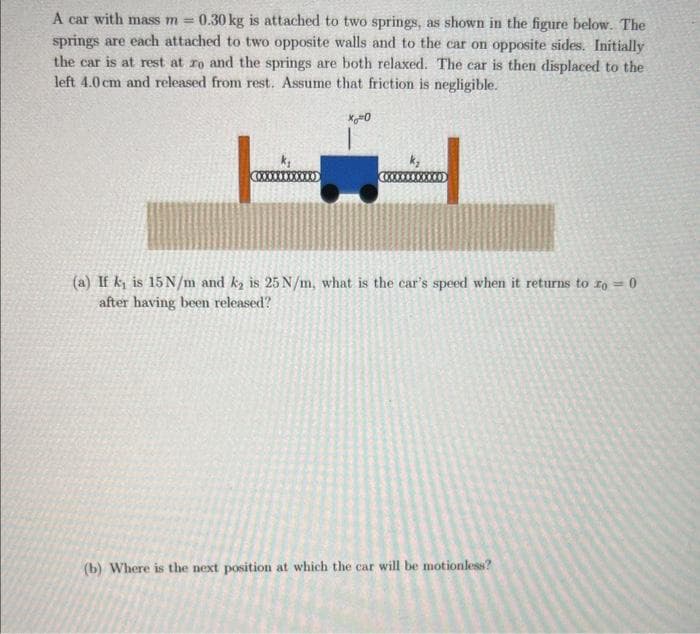A car with mass m = 0.30 kg is attached to two springs, as shown in the figure below. The springs are each attached to two opposite walls and to the car on opposite sides. Initially the car is at rest at ro and the springs are both relaxed. The car is then displaced to the left 4.0 cm and released from rest. Assume that friction is negligible. X=0 (a) If k, is 15 N/m and k₂ is 25 N/m, what is the car's speed when it returns to ro = 0 after having been released? (b) Where is the next position at which the car will be motionless?
A car with mass m = 0.30 kg is attached to two springs, as shown in the figure below. The springs are each attached to two opposite walls and to the car on opposite sides. Initially the car is at rest at ro and the springs are both relaxed. The car is then displaced to the left 4.0 cm and released from rest. Assume that friction is negligible. X=0 (a) If k, is 15 N/m and k₂ is 25 N/m, what is the car's speed when it returns to ro = 0 after having been released? (b) Where is the next position at which the car will be motionless?
Principles of Physics: A Calculus-Based Text
5th Edition
ISBN:9781133104261
Author:Raymond A. Serway, John W. Jewett
Publisher:Raymond A. Serway, John W. Jewett
Chapter7: Conservation Of Energy
Section: Chapter Questions
Problem 5P: A block of mass 0.250 kg is placed on top of a light, vertical spring of force constant 5 000 N/m...
Related questions
Question

Transcribed Image Text:A car with mass m = 0.30 kg is attached to two springs, as shown in the figure below. The
springs are each attached to two opposite walls and to the car on opposite sides. Initially
the car is at rest at ro and the springs are both relaxed. The car is then displaced to the
left 4.0 cm and released from rest. Assume that friction is negligible.
X=0
(a) If k, is 15 N/m and k₂ is 25 N/m, what is the car's speed when it returns to zo = 0
after having been released?
(b) Where is the next position at which the car will be motionless?
Expert Solution
This question has been solved!
Explore an expertly crafted, step-by-step solution for a thorough understanding of key concepts.
This is a popular solution!
Trending now
This is a popular solution!
Step by step
Solved in 3 steps with 3 images

Knowledge Booster
Learn more about
Need a deep-dive on the concept behind this application? Look no further. Learn more about this topic, physics and related others by exploring similar questions and additional content below.Recommended textbooks for you

Principles of Physics: A Calculus-Based Text
Physics
ISBN:
9781133104261
Author:
Raymond A. Serway, John W. Jewett
Publisher:
Cengage Learning

Physics for Scientists and Engineers: Foundations…
Physics
ISBN:
9781133939146
Author:
Katz, Debora M.
Publisher:
Cengage Learning

University Physics Volume 1
Physics
ISBN:
9781938168277
Author:
William Moebs, Samuel J. Ling, Jeff Sanny
Publisher:
OpenStax - Rice University

Principles of Physics: A Calculus-Based Text
Physics
ISBN:
9781133104261
Author:
Raymond A. Serway, John W. Jewett
Publisher:
Cengage Learning

Physics for Scientists and Engineers: Foundations…
Physics
ISBN:
9781133939146
Author:
Katz, Debora M.
Publisher:
Cengage Learning

University Physics Volume 1
Physics
ISBN:
9781938168277
Author:
William Moebs, Samuel J. Ling, Jeff Sanny
Publisher:
OpenStax - Rice University

Physics for Scientists and Engineers, Technology …
Physics
ISBN:
9781305116399
Author:
Raymond A. Serway, John W. Jewett
Publisher:
Cengage Learning

College Physics
Physics
ISBN:
9781285737027
Author:
Raymond A. Serway, Chris Vuille
Publisher:
Cengage Learning

Classical Dynamics of Particles and Systems
Physics
ISBN:
9780534408961
Author:
Stephen T. Thornton, Jerry B. Marion
Publisher:
Cengage Learning